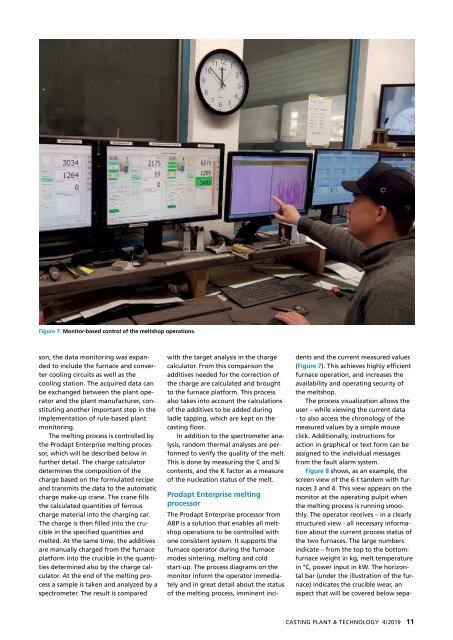CPT International 4/2019
You also want an ePaper? Increase the reach of your titles
YUMPU automatically turns print PDFs into web optimized ePapers that Google loves.
Figure 7: Monitor-based control of the meltshop operations.<br />
son, the data monitoring was expanded<br />
to include the furnace and converter<br />
cooling circuits as well as the<br />
cooling station. The acquired data can<br />
be exchanged between the plant operator<br />
and the plant manufacturer, constituting<br />
another important step in the<br />
implementation of rule-based plant<br />
monitoring.<br />
The melting process is controlled by<br />
the Prodapt Enterprise melting processor,<br />
which will be described below in<br />
further detail. The charge calculator<br />
determines the composition of the<br />
charge based on the formulated recipe<br />
and transmits the data to the automatic<br />
charge make-up crane. The crane fills<br />
the calculated quantities of ferrous<br />
charge material into the charging car.<br />
The charge is then filled into the crucible<br />
in the specified quantities and<br />
melted. At the same time, the additives<br />
are manually charged from the furnace<br />
platform into the crucible in the quantities<br />
determined also by the charge calculator.<br />
At the end of the melting process<br />
a sample is taken and analyzed by a<br />
spectrometer. The result is compared<br />
with the target analysis in the charge<br />
calculator. From this comparison the<br />
additives needed for the correction of<br />
the charge are calculated and brought<br />
to the furnace platform. This process<br />
also takes into account the calculations<br />
of the additives to be added during<br />
ladle tapping, which are kept on the<br />
casting floor.<br />
In addition to the spectrometer analysis,<br />
random thermal analyses are performed<br />
to verify the quality of the melt.<br />
This is done by measuring the C and Si<br />
contents, and the K factor as a measure<br />
of the nucleation status of the melt.<br />
Prodapt Enterprise melting<br />
processor<br />
The Prodapt Enterprise processor from<br />
ABP is a solution that enables all meltshop<br />
operations to be controlled with<br />
one consistent system. It supports the<br />
furnace operator during the furnace<br />
modes sintering, melting and cold<br />
start-up. The process diagrams on the<br />
monitor inform the operator immediately<br />
and in great detail about the status<br />
of the melting process, imminent incidents<br />
and the current measured values<br />
(Figure 7). This achieves highly efficient<br />
furnace operation, and increases the<br />
availability and operating security of<br />
the meltshop.<br />
The process visualization allows the<br />
user – while viewing the current data<br />
- to also access the chronology of the<br />
measured values by a simple mouse<br />
click. Additionally, instructions for<br />
action in graphical or text form can be<br />
assigned to the individual messages<br />
from the fault alarm system.<br />
Figure 8 shows, as an example, the<br />
screen view of the 6-t tandem with furnaces<br />
3 and 4. This view appears on the<br />
monitor at the operating pulpit when<br />
the melting process is running smoothly.<br />
The operator receives – in a clearly<br />
structured view - all necessary information<br />
about the current process status of<br />
the two furnaces. The large numbers<br />
indicate – from the top to the bottom:<br />
furnace weight in kg, melt temperature<br />
in °C, power input in kW. The horizontal<br />
bar (under the illustration of the furnace)<br />
indicates the crucible wear, an<br />
aspect that will be covered below sepa-<br />
CASTING PLANT & TECHNOLOGY 4/<strong>2019</strong> 11

















